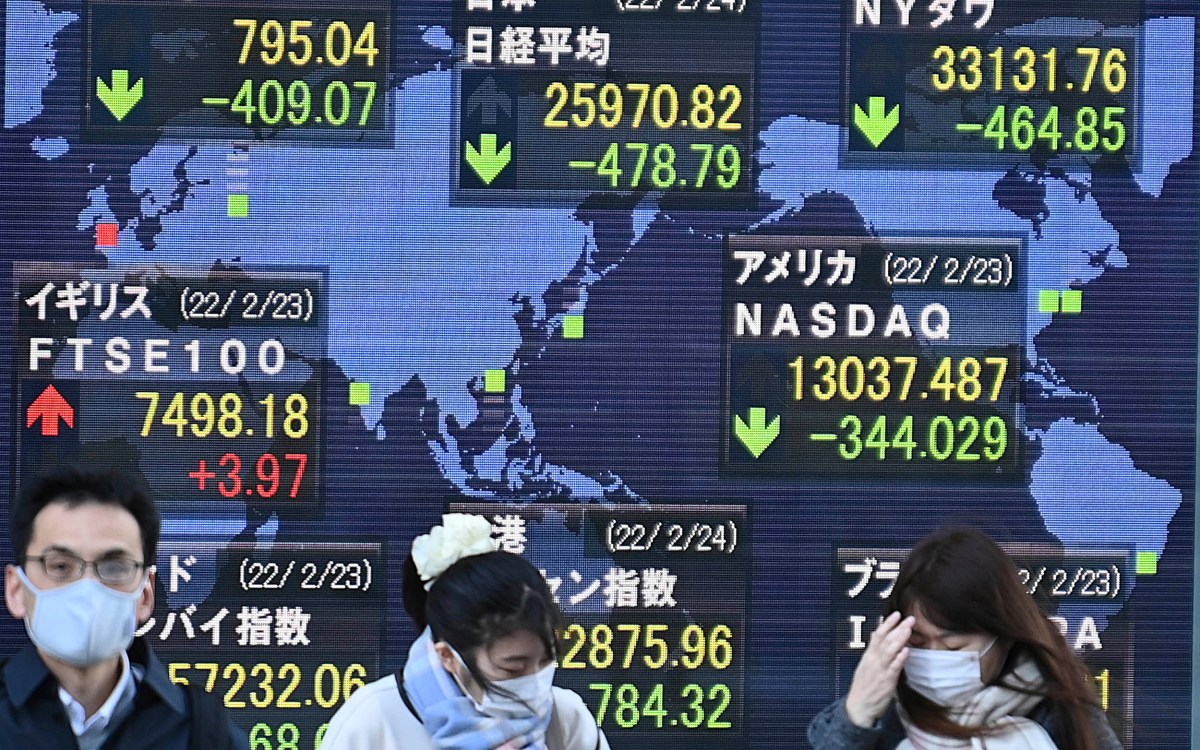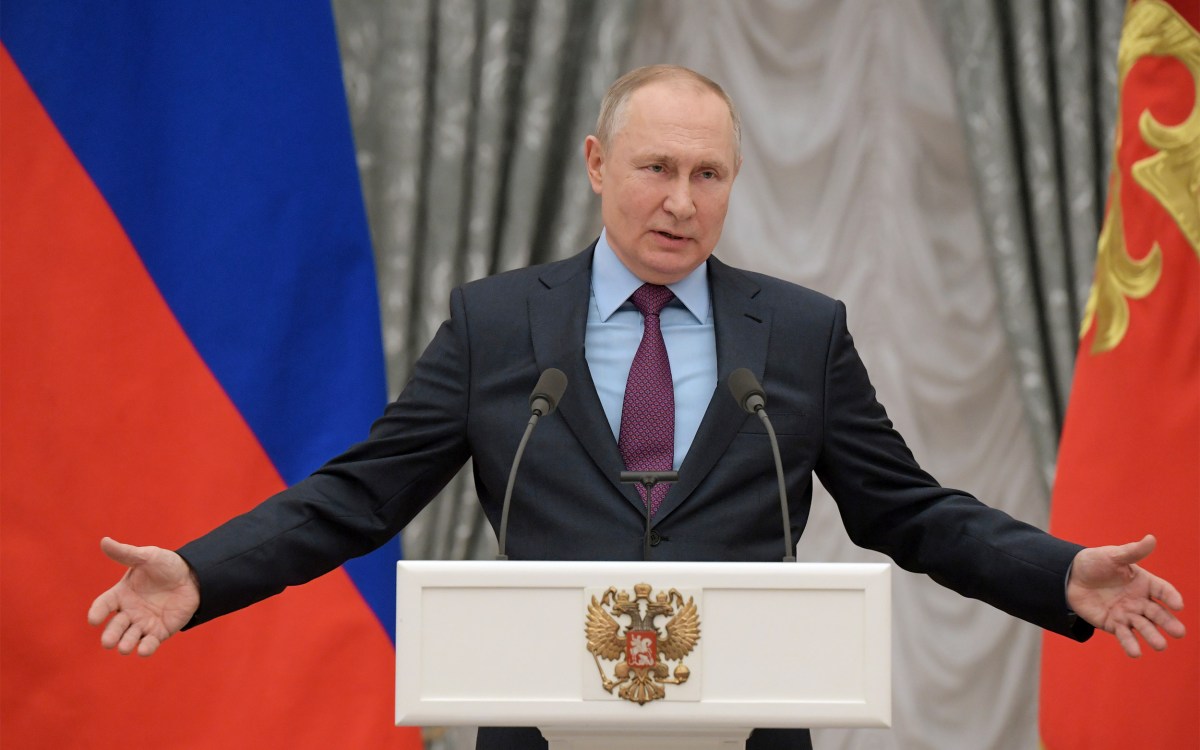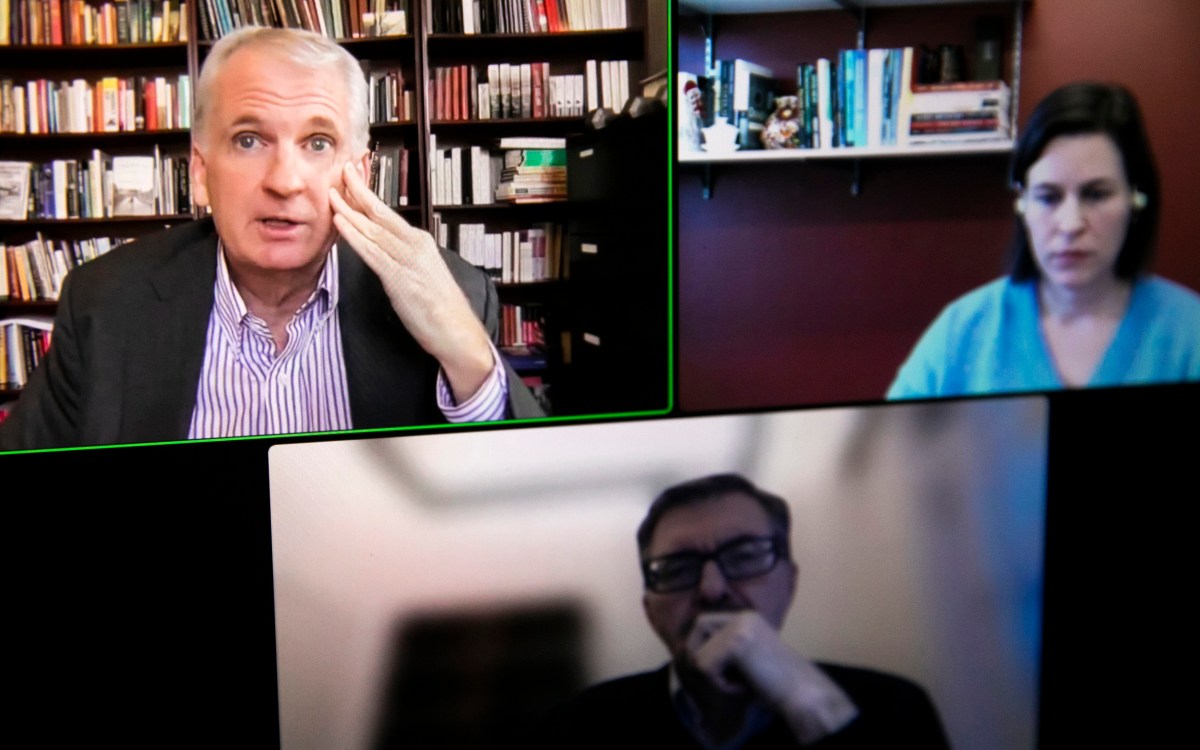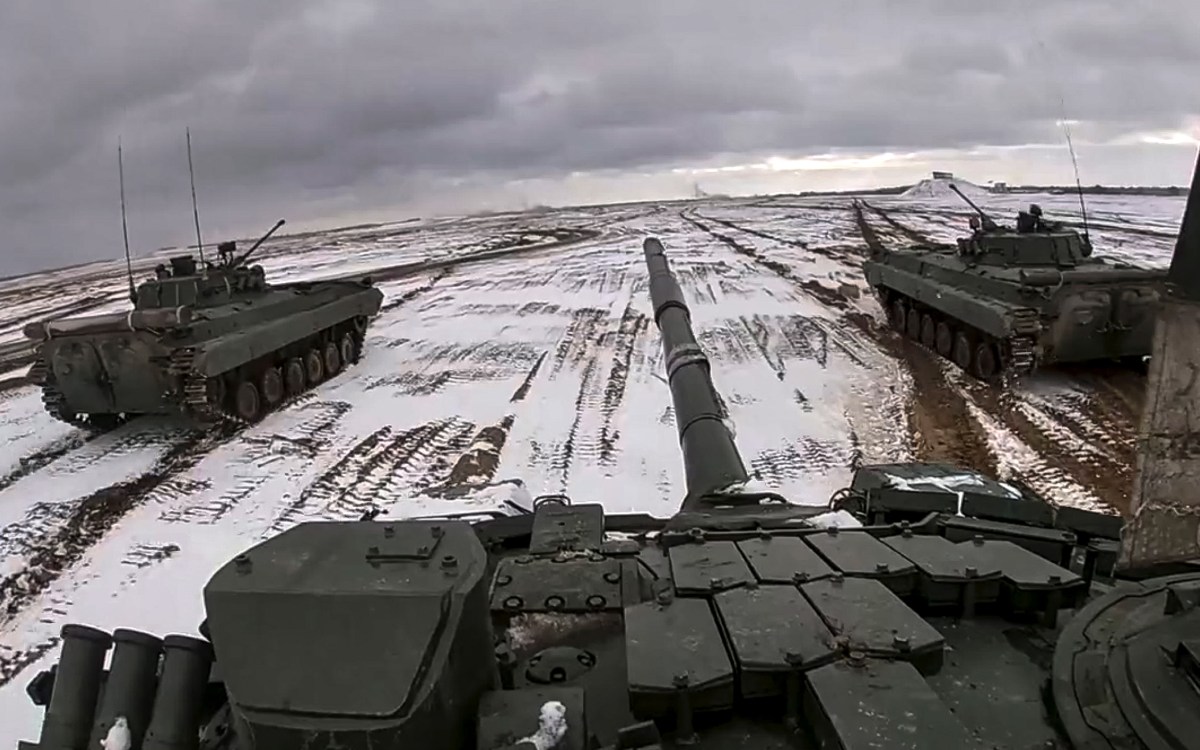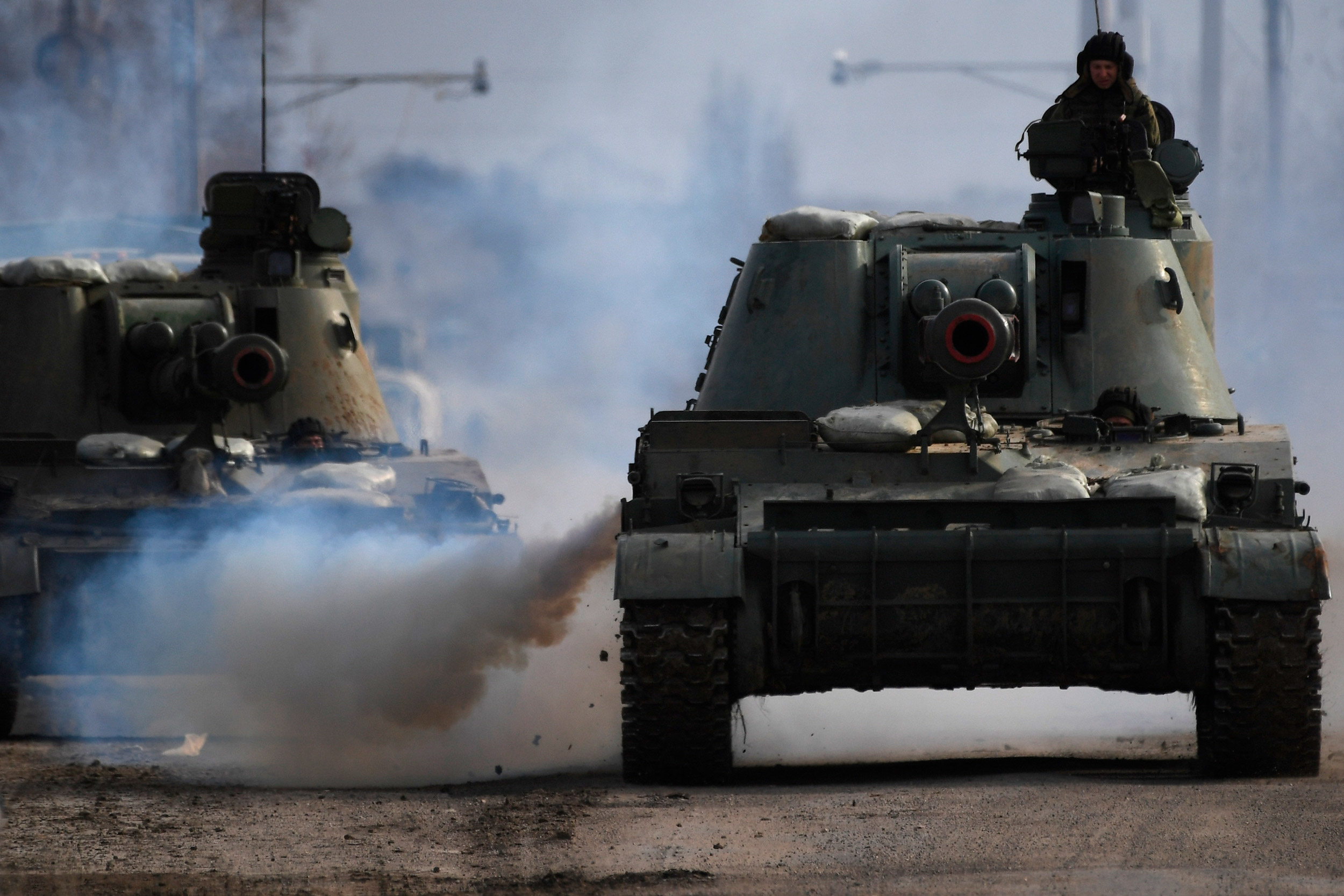
Armored vehicles drive along a road in Armyansk in the northern part of Crimea, Russia.
Konstantin Mihalchevskiy/Sputnik via AP
What happens next in Ukraine?
As attack unfolds, escalation, nuclear standoff among Harvard experts’ worst fears
With Russian troops in full-scale assault against Ukraine, a key step for the U.S. and its NATO allies should be tripling combat-ready troops in the Baltics and NATO-allied eastern Europe to deter any thought of a Ukraine-style incursion there.
Retired Brigadier Gen. Kevin Ryan, a senior fellow at Harvard’s Belfer Center for Science and International Affairs, said even though it is unlikely that Russia would invade Estonia, Latvia, and Lithuania, their NATO membership, Lithuania’s borders with Russia-friendly Belarus, and Estonia and Latvia’s with Russia raise the stakes of a broader conflict. He said concrete steps to deter Russian President Vladimir Putin should be taken.
Ryan and other Russia experts at Harvard say that it’s difficult to predict exactly what Putin’s next move will be. But it seems likely that he will avoid taking on NATO directly as that could lead to a nuclear standoff, and so will avoid member states. Much will depend, however, on how much resistance he meets in Ukraine and how unified NATO remains through the crisis.
“Putin is not about messaging as much as he is about doing something, and we should focus more on deeds than words,” Ryan said. “It sends a message to Putin if we increase troop presence in the Baltics and Poland and so on. But more than that, the important thing would be to have those troops be combat-ready, have ammunition in a storage site nearby, have them be integrated into war plans and the defenses of those NATO countries. So, they’re not going to visit schoolchildren and have training on the weekends, they’re going there to be a valid reinforcement to the defenses that are already there.”
For the short term, however, the experts agreed, Russia is going to have its hands full with Ukraine. Russia’s larger and far superior military would likely overwhelm Ukraine’s in head-to-head combat, but it seems likely the Ukrainians will continue to offer armed resistance. Beyond that, it’s still unclear what Putin’s ultimate objectives are. Does he want to carve out territory, like the Russian-speaking eastern regions, which border Russia? He has said that he has no plans to occupy Ukraine, but will he at least try to install a Russia-friendly government?
“Ukrainians are doing the best that they can, but you can’t stop the larger, better-equipped, probably better-trained Russian army moving in on three sides from basically getting to its objective,” said Alexandra Vacroux, executive director of Harvard’s Davis Center for Russian and Eurasian Studies. “But what are they going to do after that? We can say that there’s no way the Ukrainian army can stop them, but we can also say that there’s no way an army of even 200,000 Russian troops is going to be able to hold a country of 43 million people.”
The large cities may prove a particular problem, Vacroux said.
“The Russians learned in Chechnya the same lesson that we learned in Mosul, which is it’s extremely difficult to hold cities,” Vacroux said. “It’s gruesome and bloody and requires a huge amount of human force. I just don’t see the ‘day after’ strategy, from the Russian point of view.”
Experts said in the days and weeks to come, they’d be looking for things like how much of a fight the Ukrainian army puts up and whether they can drag the battle out and increase the Russian body count. Can the Russians take the capital of Kiev, and, if so, what happens there, both to the city itself and to the government?
Another key is the final package of sanctions from Western nations that get passed and their effect on Russia. And how well do NATO nations opposing Putin hang together? Putin, Vacroux said, has long said that the West has become weak and fractured.
“In many ways, the administration learned the lessons of the mistakes we made after Russia annexed Crimea in 2014, where we impose some sanctions and nothing much happened,” Vacroux said. “The Russians concluded that they could basically do this again if they wanted. The West wasn’t going to be spending money and personnel and materiel defending Ukraine.”
Vacroux said releasing intelligence about Russia’s moves and motives, which Russia first denied and then confirmed once they were executed, removed the element of surprise and seemed to unsettle Putin. She said she was stunned how much events unspooled as predicted.
“Even if you’re expecting something, you can still be surprised by it,” Vacroux said. “I think we’re all surprised at how overwhelming the Russian invasion has been. It’s a little bit like watching a car crash happen. You can’t do anything to stop it, and you still feel terrible watching it happen.”
Experts said it is too early to know Putin’s long-range plans, but if he has designs on other nations, Moldova, which borders Ukraine to the west, and Georgia, which once also flirted with NATO membership, are possible targets. Most other countries that might otherwise be candidates — Poland and the Baltics — are already NATO members.
“If he threatens those countries, he’s threatening NATO, and he’s declaring World War III,” said Thomas Nichols, University Professor at the U.S. Naval War College and an instructor at Harvard Extension School. “As reckless as Putin has become, he’s not that reckless.”
That said, once shooting starts, the threat of the crisis escalating into nuclear war, while remote, nonetheless exists. Both the U.S. and Russia have a history of signaling with their nuclear-capable forces, as Putin did in the days leading up to the invasion by conducting nuclear force drills. The message, Nichols said, was don’t send NATO forces into Ukraine, or Russia, for that matter.
Though the U.S. has the more powerful military overall, Nichols said it’s something like comparing apples and oranges, since the Russian military is a large, mostly land-based force, while the U.S. military is designed to project force far from home. The danger of a nuclear war between the two nations — Russian nukes could obliterate the Northern Hemisphere if it came to that — almost makes the differences in their conventional forces beside the point.
Historically, experts said there are similar examples of heading to the brink from the past: the Yom Kippur War of 1973, when it was the U.S. that ran nuclear drills to keep the Soviet Union from intervening in the Middle East; the Cuban Missile Crisis, which this conflict, from a nuclear confrontation standpoint, doesn’t yet approach; even the Korean War, which began when Stalin gave the North Koreans permission to try to take the whole country. It was only a few years ago when Turkey shot down a Russian jet over the Syrian border, which both countries decided not to escalate. Nichols asked: What happens now, however, amid heightened tensions, if Russia shoots down a German or Dutch jet on Ukraine’s border?
“We’re not there yet,” Nichols said of comparisons to the Cuban Missile Crisis. “But I also admit to having kind of a pit, a lump in my stomach. We’re talking about the biggest war in Europe since World War II and anytime you put this many troops in motion, bad things, unintended things can happen. That’s what really worries me, is that this becomes a bigger crisis by accident.”



